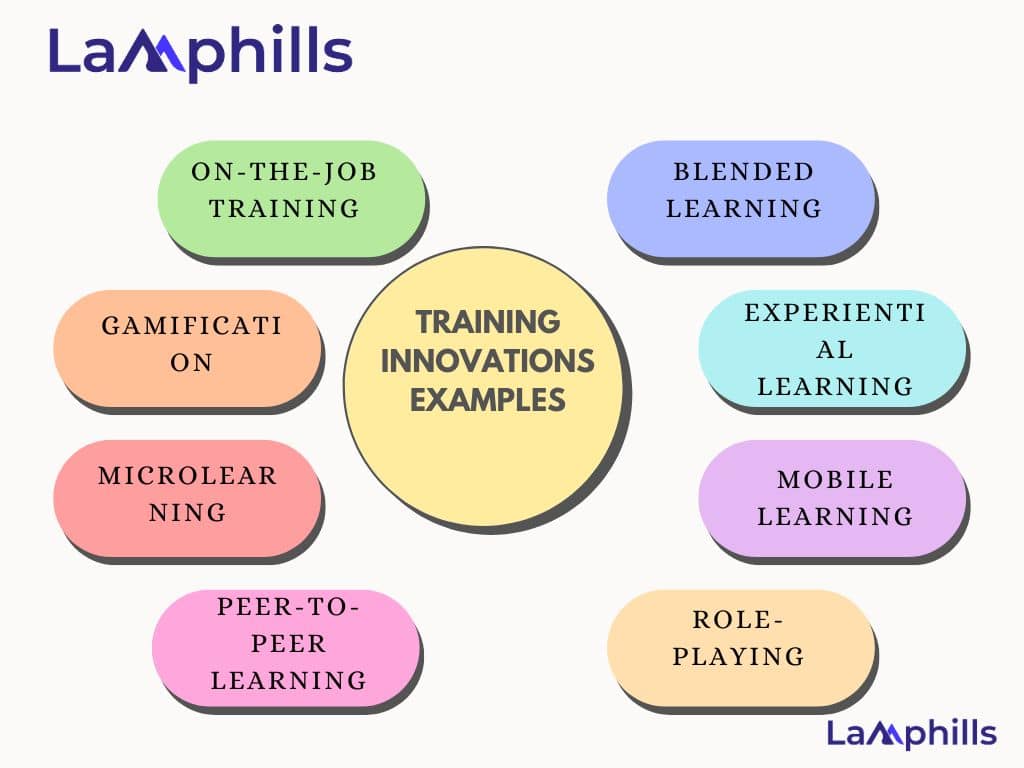Have you ever wondered how training innovations reshape how we think and solve problems beyond memorizing facts? It’s fascinating to see how different these methods are from traditional training sessions. Instead of the usual approach, they combine cutting-edge technology, creative strategies, and deep insights to revolutionize skill and knowledge development. In this article, I will share with you the eight innovative training strategies you must consider for new employees.
Key point
- Innovation training involves teaching new ideas and methods, enabling employees to understand and apply innovative strategies to foster organizational growth and adaptability.
- Training innovations provide numerous benefits, including adaptation to new technologies, skill enhancement, increased productivity, attraction of top talent, competitive advantage, and opportunities for internal promotions, all contributing to overall employee motivation and satisfaction.
- It’s essential to avoid pitfalls such as lack of clarity, insufficient feedback, using outdated methods, overwhelming employees, not tailoring training to individual needs, and lack of support when developing training strategies.
- Practical training enhances skills, encourages creative thinking, fosters collaboration, boosts confidence, promotes continuous improvement, and keeps teams current with industry trends.
What Is Innovation in Training?

Credit: Freeiks
Innovation training is a program or class that teaches people how to understand and use new ideas and methods. What you learn in innovation training can differ depending on where you take it.
For example, Harvard Business School Professor Clayton Christensen teaches an online Disruptive Strategy course. In this course, students learn how to organize their resources and processes to create an innovative environment, evaluate new opportunities and possible challenges in their fields, and use disruption to help their organizations grow.
Training Innovations Examples
Here are examples of Innovative Training Strategies for New Employees:
#1. On-the-Job Training
On-the-job training is one of the most effective ways to train new employees. It involves learning by doing the job with guidance from experienced colleagues. This hands-on approach includes shadowing, mentoring, and apprenticeships. It provides practical experience and helps new employees build relationships within the team.
#2. Gamification
Gamification involves adding game-like elements to training programs to make them more engaging and interactive. You can use online games, simulations, or quizzes to test new employees’ knowledge and skills. For example, Deloitte uses a game called “Deloitte Cyber Detectives” to train employees on cybersecurity through simulated real-world attacks.
#3. Microlearning
Microlearning breaks down information into small, manageable pieces. This method allows new employees to learn at their own pace and on their schedule. Microlearning content can be delivered through videos, podcasts, and infographics. LinkedIn Learning uses this method, offering short, focused courses with videos lasting between 2 to 10 minutes.
#4. Peer-to-Peer Learning
Peer-to-peer learning involves new employees learning from their colleagues. This approach helps build relationships and facilitates knowledge sharing. It can include lunch and learns, mentoring, and job shadowing. For example, Microsoft’s “Mentor Match” program connects new employees with experienced mentors.
#5. Blended Learning
Blended learning combines traditional classroom training with online learning. This method allows new employees to benefit from face-to-face interaction and online courses’ flexibility. Companies like Google and Amazon use blended learning to train employees, mixing e-learning with in-person sessions.
#6. Experiential Learning
Experiential learning involves learning through hands-on experience. This approach helps new employees develop their skills and knowledge by engaging in simulations, role-playing, and group projects. Ernst & Young (EY) uses experiential learning to train employees on consulting skills through their “EY Business Simulation” program.
#7. Mobile Learning
Mobile learning uses mobile devices to deliver training content, making it ideal for employees who need access to training on the go. This can include videos, podcasts, and e-books. McDonald’s, for example, has an app called “McDonald’s MyStuff” that provides training content that is accessible on mobile devices.
#8. Role-Playing
Role-playing involves acting out scenarios that employees will likely encounter on the job. This method helps develop problem-solving and communication skills. Companies like Zappos use role-playing exercises in their “The Zappos Way of W.O.W.” program to train employees in customer service.

Pitfalls to Avoid When Developing Training Strategies for New Employees
When creating training strategies for new employees, it’s crucial to avoid common pitfalls to ensure the process is effective and efficient.
- Lack of Clarity: Clear and concise instructions are essential. Employees must thoroughly understand their job responsibilities, company policies, and procedures to ensure everything is correct.
- Not Providing Enough Feedback:Regular, constructive feedback is crucial for helping employees understand what they’re doing well and where they need improvement. This boosts confidence and job satisfaction.
- Using Outdated or Ineffective Training Methods:Utilize innovative and engaging training methods to ensure better retention and job satisfaction. Outdated methods can lead to lower productivity and engagement.
- Overwhelming Employees:Avoid overwhelming employees with too much information at a time. Break the training process into manageable sections and provide ample time for practice and reinforcement.
- Not Tailoring Training to Employee Needs: Tailor the training process to individual employee needs to ensure effective learning. A one-size-fits-all approach can lead to frustration and lower engagement.
- Lack of Support: Provide adequate support through coaching, mentoring, or additional resources. This helps employees feel valued and contributes to their job satisfaction and retention.
By avoiding these pitfalls, organizations can create a positive and productive learning environment that supports their and their employees’ long-term success.
What Are the Benefits of Training Innovations?
Training Innovations and development for employees offer numerous benefits, from boosting engagement to enhancing productivity and satisfaction at work. Here are five key advantages of enrolling employees in innovation courses:
#1. Adaptation to New Technologies and Work Models
The world constantly evolves, and employees must keep up with new technologies and work models. Innovation courses help employees learn how to navigate these changes effectively, enhancing their ability to handle daily challenges.
#2. Skill Enhancement and Productivity Boost
Innovation courses enable employees to refine their skills, increasing productivity. Employees can perform their jobs more efficiently and effectively by working on their knowledge and acquiring advanced skills.
#3. Attracting Top Talent
Offering on-the-job training helps a business create a unique identity in the market. This attractive perk draws talented individuals, ensuring a more skilled and capable workforce.
#4. Competitive Advantage Training
the existing workforce gives companies a competitive edge. According to a report, top U.S. companies that invested in employee training saw profits increase by 37% per employee, highlighting the financial benefits of such initiatives.
#5. Internal Promotions and Employee Motivation
Skill development courses allow employees to compete for internal promotions. Those who acquire new skills through training are often promoted faster than their peers. This recognition boosts morale and encourages further professional growth.
Innovation training and development for employees provide numerous benefits that can significantly impact a company’s success. If you’re considering introducing innovative courses for your team, MIT ID Innovation is an excellent choice to help you get started.
How Does Training Contribute to a Team Becoming Innovative?

Credit: DC studio
Training plays a crucial role in fostering innovation within a team. By equipping team members with the right skills and knowledge, training can drive creativity and innovation in several key ways:
#1. Enhancing Skills and Knowledge
Training helps team members develop and refine their skills. When employees are well-versed in the latest technologies and methodologies, they are more likely to develop innovative solutions to problems. Continuous learning keeps everyone up-to-date and ready to tackle new challenges with fresh perspectives.
#2. Encouraging Creative Thinking
Innovation thrives in an environment where creative thinking is encouraged. Training programs focusing on creative problem-solving and unconventional thinking can inspire team members to approach tasks differently, leading to the development of novel ideas and innovative strategies.
#3. Fostering Collaboration and Teamwork
Effective training programs often include collaborative projects and team-building exercises. These activities help build strong relationships among team members, promoting a culture of collaboration. People working well together can pool their diverse skills and knowledge to create innovative solutions.
#4. Boosting Confidence
When employees are confident in their abilities, they are more likely to take risks and propose new ideas. Training provides the tools and support necessary to build this confidence. With a solid foundation of knowledge and skills, team members are empowered to innovate without fear of failure.
#5. Encouraging Continuous Improvement
A commitment to training signals that a company values continuous improvement. This mindset encourages employees to constantly seek better ways of doing things, which is the essence of innovation. By regularly updating their skills and knowledge, team members look for opportunities to improve processes and outcomes.
#6Keeping Up with Industry Trends Training
Ensures a team stays current with industry trends and advancements. This awareness of the latest developments can spark new ideas and approaches, helping the team stay ahead of the curve. Being at the forefront of industry changes is essential for driving innovation.
In conclusion, training is a vital component in developing an innovative team. Training creates an environment where innovation can flourish by enhancing skills, encouraging creative thinking, fostering collaboration, boosting confidence, promoting continuous improvement, and staying current with industry trends.
Read: The Essential Role of a Communications Officer: Responsibilities, Skills, and How To Become One
How To Train Employees for Innovation?
Training is critical to making the team innovative. By giving team members the right skills and knowledge, training can drive creativity and innovation in several important ways:
#1. Improving Skills and Knowledge
Training Innovations helps team members sharpen and expand their skills. When employees know the latest technologies and methods, they’re better at finding creative solutions to problems. Continuous learning keeps everyone ready to face new challenges with fresh ideas.
#2. Promoting Creative Thinking
Innovation happens when creative thinking is encouraged. Training that focuses on solving problems in new ways can inspire team members to think differently. This can lead to new ideas and innovative strategies.
#3. Building Collaboration and Teamwork
Good training programs often include group projects and team-building activities. These help build strong relationships among team members, promoting a culture of collaboration. When people work well together, they can combine their skills and knowledge to create innovative solutions.
#4. Increasing Confidence
Confident employees are more likely to take risks and suggest new ideas. Training Innovations gives the tools and support needed to build this confidence. With a solid foundation of skills, team members feel empowered to innovate without fearing failure.
#5. Encouraging Continuous Improvement
A commitment to training shows that a company values constant improvement. This mindset encourages employees to always look for better ways to do things, which is the heart of innovation. Team members continually seek to improve processes and outcomes by regularly updating their skills and knowledge.
#6. Staying Current with Industry Trends
Training Innovations ensures that a team stays up-to-date with industry trends and advancements. Knowing the latest developments can spark new ideas and approaches, helping the team stay ahead. Being aware of industry changes is essential for driving innovation.
In summary, training is crucial for developing an innovative team. Training creates an environment where innovation can thrive by improving skills, promoting creative thinking, building collaboration, increasing confidence, encouraging continuous improvement, and staying current with industry trends.
Check out 15 INTRIGUING PR TRENDS TO WATCH OUT FOR NOW!! (DETAILED INSIGHTS)
The Importance of Training for Boosting Team Creativity
Creativity is essential for innovation and success in today’s fast-changing market. Businesses are realizing the importance of nurturing creativity in their employees through practical training and development.
Employees with a creative mindset can come up with fresh solutions to problems, develop new products and services, and improve efficiency. This gives a business a competitive edge and helps it lead the market.
Organizations can adopt various strategies to build a culture of creativity within the team. Here are some critical tips for fostering creativity and specific training activities to boost creative thinking:
Fostering a Culture of Creativity
- Promote an Open Environment for Ideas and Experimentation: Encourage employees to share their ideas freely, no matter how unconventional. Be open-minded about new concepts and willing to try out novel strategies.
- Provide Opportunities for Creative Thinking: Create platforms for innovative thinking, such as brainstorming sessions, innovation challenges, and cross-functional collaborations. Give employees time to work on creative projects independently, allowing their ideas to grow.
- Encourage Continuous Learning and Skill Development: Motivate employees to explore new knowledge by taking courses, reading relevant material, attending workshops, and engaging with industry experts. Continuous learning stimulates creativity and broadens their problem-solving abilities.
- Recognize and Reward Creative Contributions: Set up a system to recognize and celebrate employees who contribute new ideas. Appreciating creativity reinforces its value and motivates others to think creatively.
Specific Training Activities to Boost Creativity
- Brainstorming Sessions: Use brainstorming to generate ideas for solving problems or improving products and services. Start with a ‘quantity over quality’ approach, then refine and select the best ideas.
- Role-playing Exercises: Engage employees in role-playing to stimulate innovative thinking. Employees can enhance their problem-solving skills by imagining different scenarios and creating creative solutions.
- Design Thinking Workshops: Adopt design thinking, which involves understanding user needs, ideation, prototyping, and testing. This approach is practical for creating or refining products and services with a human-centered focus.
- Creative Writing Workshops: Organize creative writing exercises to help employees develop their imagination and problem-solving abilities. Assign topics and encourage the creation of stories, poems, or essays to foster creativity.
Read P.R. Business Meaning & How to Start!!! (Detailed Guide)
Cultivating Creativity Beyond Training
- Provide Resources to Support Creativity: Ensure employees access modern technology, research materials, and creative tools to facilitate innovative thinking.
- Empower Through Autonomy and Flexibility: Allow employees to set goals and deadlines. Providing flexibility, including options for remote work, enhances their creative potential.
- Facilitate Collaboration and Idea Sharing: Encourage collaboration within the team and with professionals from diverse fields. Different perspectives enrich creativity and generate new ideas.
- Celebrate Diversity of Thought: Recognize and appreciate employees’ diverse experiences and viewpoints. A diverse workforce brings a wealth of perspectives that can foster a creative environment.
Training Innovations is vital for cultivating a team’s creativity and innovation culture. By following these strategies, organizations can create a dynamic, innovative workforce ready to tackle any challenge.
Related post
Corporate Communications: Strategies to Amplify Your Brand’s Message
What Journalists Want in a Media Advisory (And What to Avoid) + Free Templates
Brand Journalism: Everything You Should Know About






